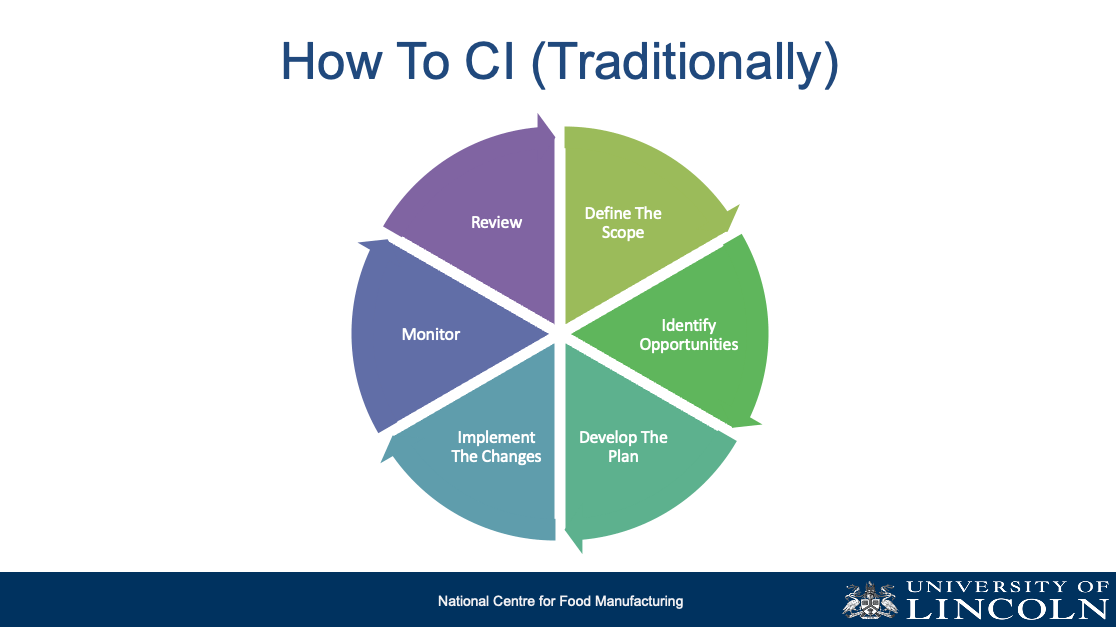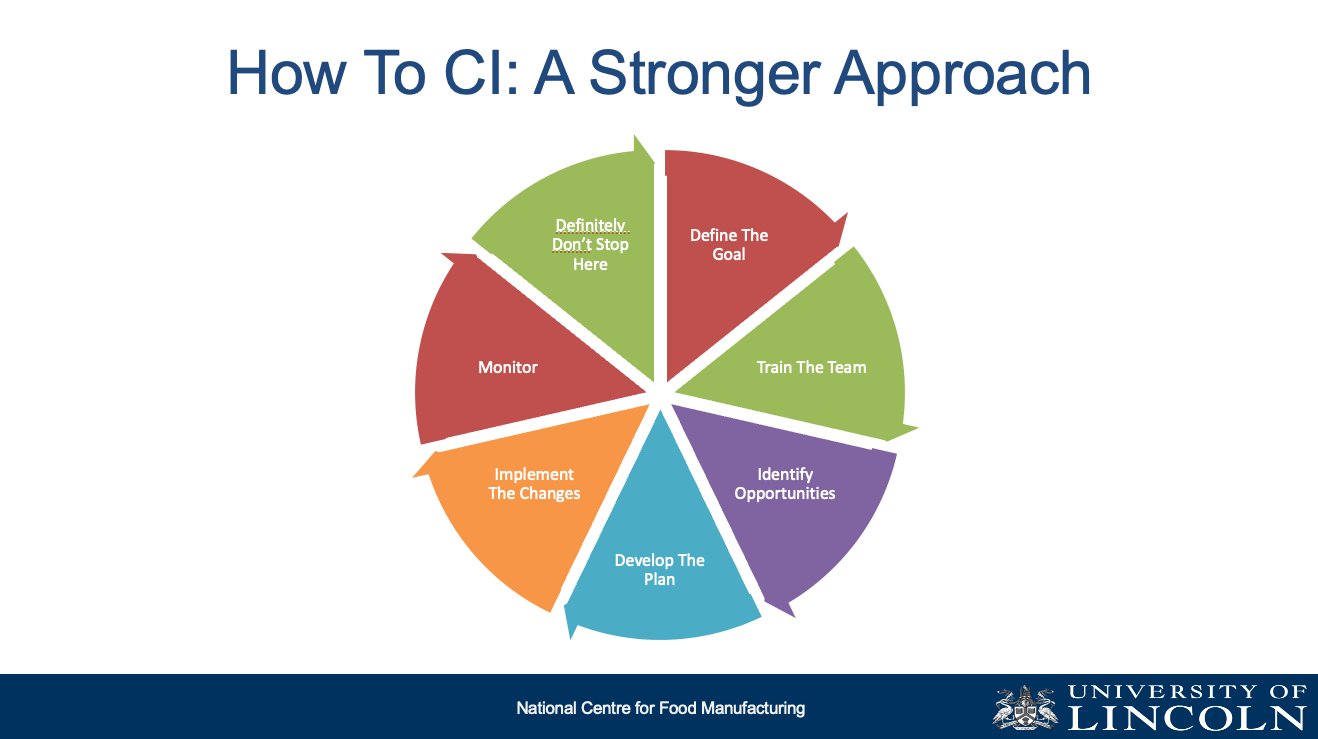Focusing on culture to continuously improve
See what Trevor Hewson from the University of Lincoln had to say about making continuous improvement stick for manufacturers.

At Factbird Forward 2024, Trevor Hewson, lecturer at the University of Lincoln and part of the National Centre for Food Manufacturing, gave us an insightful talk on what companies can do to drive continuous improvement. Trevor comes with a manufacturing background and expertise of over 30 years, so he knows what he's talking about!
To truly drive change, you need to put your people at the center. How can we drive improvement in the here and now?
The following is a slightly summarized version of what Trevor presented at the event.
A little factory story
Trevor begins by telling a story about a factory, one that's part of a multi-site organization. A pretty large factory with around 1,300 people working there. However, it was losing 10 million pounds against budget on a yearly basis.
So they've got problems with poor staff retention, partly due to location, but also due to competitors in the area. Production from that site was interchangeable between other sites. Now, that put this place at risk of closing and losing 1,300 jobs in a pretty deprived area. We're going to come back to that and find out what happened with that site.
Beyond Industry 3.0
One of the things Trevor was asked to think about when he was invited to Factbird Forward was, how does industry 3.0 link into industry 4.0?

He says this flow has been natural. It goes back to Henry Ford with his piece of paper watching cars being made. He was analyzing data, but it just took him a lot longer. We're now in a position where we can analyze that data and get that data in really quickly.
Effectively how that data is used is going to change massively. And this is where continuous improvement comes in.
How to do continuous improvement (traditionally)
Traditionally, continuous improvement has worked followed this process:
- Define the scope
- Identify opportunities
- Develop the plan
- Implement the changes
- Monitor what's going on
- Review and understand if it worked or not

And the flow of tcontinuous improvement model, traditionall, is top-down.

That's a fairly straightforward model. Traditionally, we've got the management, the behaviors at the top of that layer, really trying to push things, really trying to make a difference.
In the middle, you've got the data layer with all the noise and all the noise coming backwards and forwards.
And then, further down you've got the processes, processes of generating the data, but not really sure how to use it. And you know, in an ideal world the flow there would be nice and fast. People able to access the data and able to use it effectively.
That's a theoretical space, the real world is different.
Theoretical space vs. real world
You can’t start your journey before you know where you are. We want to know how we can drive improvement in the here and now. How do we get there? We need a roadmap of how we got there. And you don't know where you're going to go if you don't know where you're starting. You'll get lost very, very quickly if you do.
We need to understand:
- Pockets of excellence in improvement
- Wider challenges in engagement
- Blockers to success
Within all businesses, we have little pockets of excellence. People wanting to drive, wanting to push on. We've got to grasp them and use them. The challenge is how you widen that engagement, how you pull people together, how you make sure that those pockets of excellence become pockets of growth and pockets of understanding. What stops that is the blockers to success.
The team at the University of Lincoln asked a group of professionals what their main challenges for improvement were. They came back with five main challenges:
- Scaling CI
- Capability building
- People engagement
- Supporting data driven-decisions
- Cross-functional collaboration

How can we fix improvement challenges?
All of that linked together is about people. Every single part of that is about people, how you utilize those people. There are brilliant systems in manufacturing. Factbird has got a number of great products for improving productivity, but we've got to access it and we've got to get the people involved to do that.
[CTA]
According to Trevor, "We've got people that are doing the jobs for you, working on the shop floor for you, haven't got the skills. 25% of adults in the UK have poor numeracy skills. That instantly presents you a challenge. How are they going to access data and understand what that data means? You did a bit better in Denmark, you've got 15%, but I think everywhere can do better than that."
Trevor added, "I was really, really pleased with what both Nikolaj and Søren talked about, the long term return on investment, being around skills and being around that knowledge and excellence. Søren mentioned someone called Lisa in the slides. Lisa was a team leader and accessed data to help them make effective decisions. Understanding what was going on. What we need is lots and lots and lots of Lisas, we need a whole shop floor to be Lisas."
How do you educate teams and make CI successful?
- By making your improvement journey part of everything you do.
- By ensuring your teams have the understanding they need.
- By not easing off.
But also, and perhaps most importantly, do not scare off your workforce.
People talk about CI, they talk about improvement, and quite often they get scared or they become disengaged because of past failures. That's a common theme through Trevor's career in the industry.
Trevor suggests a new way to approach continuous improvement. Trevor says, "I would call it skills improvement. Call it skills improvement process, get people engaged, get people bought into what they're trying to do. And going back to the chart at the beginning, I would still define the goal."

Trevor described a stronger approach to CI with a few new steps:
Define the goal: Understand the scope of the project.
Train the team: The next stage is to train the team. TYou start that early, you get people involved in that journey, start helping them to understand what brilliant systems like this can give. Making sure they do it from a steady, continual level.
The rest of it is more or less the same as the earlier model, except for when you get to the end.
Definitely don't stop here: Don't stop when you've got round that cycle. Because if you do, eventually you'll get caught up again and you'll be in the same position as you were when you started this process.
The rest of it's pretty much the same, really.
What happened in the story at the beginning?
Trevor came back to the story at the beginning of his presentation about the manufacturer facing layoffs.
"I found this quite inspirational. I worked for the business, and over the course of 4 or 5 years, we slowly turned it around. It was led by somebody quite inspirational at the top, somebody who was very much a people person and drove things. Alongside him was somebody that was incredibly driven from a knowledge and, and a grasp of the minutiae of everything they did. Those two people understood that it was a skills improvement process. They made sure that improvement activity was driven into every single person in that place."
"All 1,300 people played a part in the improvement activity there, and it really did help. It really did generate a churn. It didn't happen overnight. It took two years before we actually got control of things. However, we did. We got there. The factory turned around, this production facility making 1,300 people have a job, actually grew a little bit, grew to about 1,500 people. And it turned that 20 million loss into a 10 million profit against the budget. A real success story. Another example of how it's getting skills right, but linking it into the data, making sure the right level of data was coming along with those skills. Pulled everything together to create a sustainable change. The place is still improving, it's still getting better. You know, it's only 20 miles up the road for me, and it's really pleasing to be part of that."
"All 1,300 people played a part in the improvement activity there, and it really did help" – Trevor Hewson, lecturer at the University of Lincoln
Key takeaways
Here is a summary of the key takeaways from Trevor's presentation:
- Standardize your activity and make sure everybody's doing the same.
- Make data work as your improvement.
- Make sure your teams are educated.
- Democratize continuous improvement.
We'd highly recommend watching his full talk in the video above. Trevor shares a wealth of knowledge on how to make continuous improvement stick in your organization.
